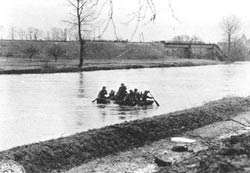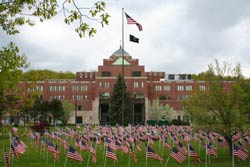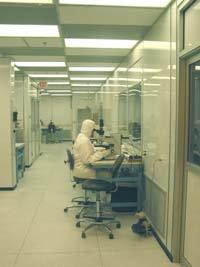About the BulzEyePro ® Optical Booster ™
How the ORIGINAL Optical Booster ™ was developed
It all begins in World War II

Although riflescope type sights have been around since the advent of the "shoot today, kill tomorrow" 45-70 sharps, there was not a real need for long-range optical sights until WWII. At this time, very accurate sniper type rifles had come into themselves since militaries from around the world became aware of the importance of such tactics in WWI.
By 1939, the Germans and Russians had developed firearms that were known as "1 of 1000". It seemed that 1 out of 1000 rifles could shoot point-of-aim every time. These rifles were put into the hands of an elite group of well-trained shooters. The men, the women, the rifles, the tactics, were known as "snipers". Until this time, a person could see farther than the rifle could shoot accurately. But now a sniper rifle could shoot 10-inch groups at 600 yards and beyond. This was much farther than the naked eye could distinguish a target. So now it was not the rifle but the scope that would limit one's ability to engage a target at long range. There were scopes out there (2 to 4 power with undependable moadials) but they were woefully inadequate. Yes, the scopes available were a damn site better than iron sights, but were not up to the task after 300 yards.
The Man Behind the Idea

Along came a great man, a United States G.I. "Regular", his friends called him "Wild Bill" or "Skid Row Bill". He arrived in North Africa in 1941 and left Germany in 1945. It has been said that the only ride he ever got was in one boat or another, traveling from North Africa to Sicily, from Sicily to Italy, and across a river here and there. He said that he walked damned near every inch of the way from Italy to Germany, via France. At age 70, 12 years before he died, he was 6'2" 280 lbs. A "gorilla" with hands of concrete...tougher than a two-dollar steak. He drank beer every day like there was no tomorrow, and smoked "White Owl" cigars. Growing up in the 1960's I would often ask him about the war, but he would seldom say a word about it.
One day I asked him what he thought when Uncle Sam ripped him from the farm, put him on a train, kicked his butt through the mud in North Carolina for three months, put him on a ship to England and then to North Africa, and after nearly five years returned him home. What could he possibly think of after all of that? He looked me square in the eye, and said, "Son, that was the first damn vacation I ever had".
After Wild Bill died, his oldest son, my uncle, shared a story of Wild Bill's war experiences with family members. He told of how an enemy sniper had killed Wild Bill's only friend in the war, and that he had, in turn, killed that man with his bare hands somewhere in Italy. Wild Bill then carried that sniper's weapon along with his M1 Garand throughout the rest of the war. This was the same rifle that Wild Bill had taught me to shoot for so many years. The sniper's rifle was not what you would expect a military rifle to be. In fact, it was not a military-type rifle at all. It was a Mannlicher, with the most beautiful walnut stock from the butt plate to near the end of the barrel, made from one solid piece of wood. It had a bolt action with a side-mounted scope.
A little "Yankee Ingenuity"
 It took a man, with a burning desire, using "Yankee ingenuity" to discover that the application of an old technology, far removed from rifle scope technology, would become the answer to his dilemma and that of many others.
It took a man, with a burning desire, using "Yankee ingenuity" to discover that the application of an old technology, far removed from rifle scope technology, would become the answer to his dilemma and that of many others.
My grandpa was always messing with the eyepiece of his scope. He had a lens attached to it with what looked like pine pitch. The lens looked like it was from a pair of eyeglasses because it had a metal rim surrounding it. The lens was made from glass and was an "orb type" (convex on both sides) lens.
After my grandfather died, I never saw that firearm again. One day while rummaging through my mother's cellar, I came upon an old wooden box. The box had about a dozen glass lenses in it along with three notebooks full of writings by my grandfather. This box and its contents brought back vivid recollections of my grandfather. I showed it to my mother and she agreed that I should have it. I took the box home and placed it on a shelf in my way to full gunroom.
After a few short days it was like this box, and the time I spent shooting with my grandfather was all that I could think about. Eventually, I found myself at the range with this box trying to make sense of it all. I had no luck until I met a distant relative, a nephew to my grandfather, who had also been in WWII. This person told me that my grandfather, Wild Bill, never got over losing his friend in Italy and that he was obsessed with the rifle that he had brought back from Europe. He went on to say that the rifle would shoot the first shot dead on every time and that the following shots would only "egg shape" the same hole at one hundred yards. He said that my grandfather and an eye doctor friend of his were trying to improve the scope. There, I thought, I have answered my questions, now I can lay this to rest.
About two weeks later I got a call from the eye doctor who had been working with my grandfather. He had just run into my grandfather's nephew. The doctor said that he had never stopped looking for a solution and that he had over 200 lenses that he had worked with. His son, an eye surgeon, had taken over his practice as well as his quest to develop a technology parallel to the lens that my grandfather was in search of. The eye doctor and I arranged a meeting to talk further. We meet for lunch, which turned into cocktails and dinner, and a trip to the range on the following day. At the range, it became evident to me that these people are the answer to my granddad's dream and I to theirs.
After a little more than two years, we discontinued the development of glass lenses and began to work with polycarbonate. We soon find out that the equipment technology that we were using was designed for glass. Then we discover that there is no equipment available to decipher our calculations when plugging in the numbers for polycarbonate. And then along came General Electric, Nassau, and the United States Military, following in our footsteps.
After 20 years of repeated, extensive experimentation and testing, one day, J.B. Shaw, our senior design engineer concluded that we had gotten it right! We had produced a lens that successfully addresses all of the known illusions and problems faced by a scoped rifle shooter. The only problem left was to reduce the price of this lens from $3,000 to something affordable by the average shooter. After two years, and plenty more experiments and testing, we produced the BulzEyePro® All-Competition Optics Booster with Factory-Look Housing, released to the public April 2007. In June of 2008, we redesigned the versatile housing and created the BulzEyePro® Universal Housing for the All-Competition Optics Booster.
Today's BulzEyePro ® Optical Booster ™

In 2010 we determined the differences in light gathering capabilities between differing manufacturing techniques. Multi-composite polycarbonate "sandwiches" has proven to be the ultimate for producing high-performance images. This technique, in addition to high-performance prisms (both naturally occurring and man/machine made) has produced the highest index of refraction available from polycarbonate, and is the brightest lens available made from any present-day material and/or technique which we continue to improve.
The 75-plus years of gathering this knowledge has been a labor of love. Today, BulzEyePro® brings this technology to you. Our lenses are the finest that they can be. The housings we offer have evolved from pine pitch to what they are today - the most sophisticated, and safest way to deliver the ultimate performance of our extreme quality lenses. Our lenses and housings address and correct every known optical illusion experienced by scoped firearm shooters while increasing size and clarity of targeted image.
Don't be fooled by imitations! Like CocaCola, Pepsi, and many others, we have not patented our housings or lenses. Our lenses cannot be reverse engineered. Our success is the result of keeping our 75-plus years of data, materials, and manufacturing methods secret. We also incorporate a true love for what we do into every optical booster.
--- William Shaw III


